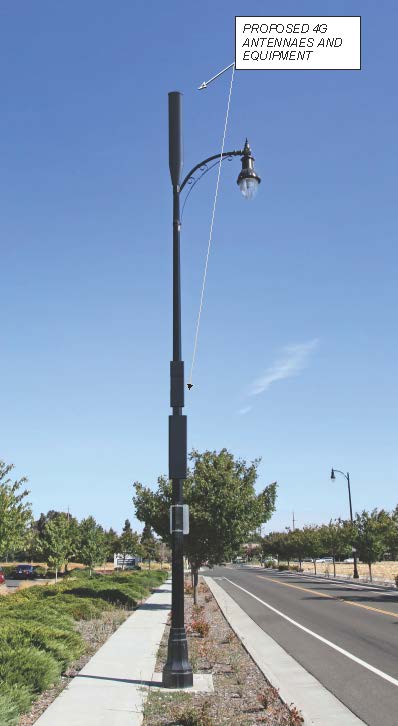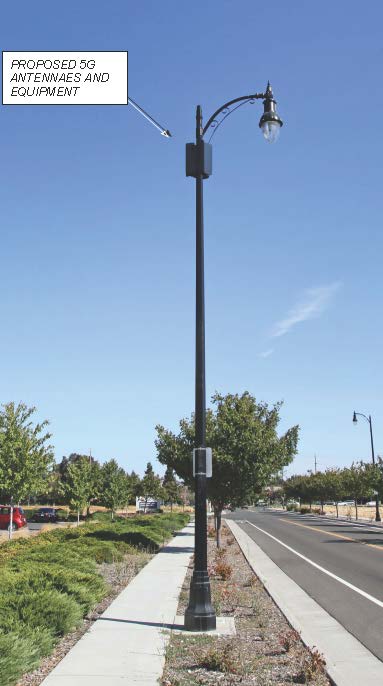This webpage provides a summary of information that may be useful to persons interested in this topic. The information on this webpage may be updated from time to time. Please note that given the complexity of this topic this webpage is intended to provide only general information about the technology and information specific to the City's permitting and regulatory policies and procedures. The City encourages readers of this webpage to conduct their own independent research for additional information.
Jump to a section:
Small Cell Technology
Historically, cellular telecommunications have utilized large antenna structures (cell sites). These cell sites are often located on existing telecommunications infrastructure, major powerlines, or on monopoles designed to blend into the surrounding environment, such as trees and flag poles. These cell sites have operated on older cellular technology (e.g., 2G, 3G) as well as the current 4G/LTE system that many cell phones use today.
The cellular telecommunications industry is beginning to deploy new forms of technology in a "small cell" format. These new systems are much smaller than traditional cell sites and may be installed on light poles, traffic signals, or small power/telephone poles. These small cells can operate with either the current 4G/LTE technology, or the newer 5G technology.

Proposed 4G antennas and equipment
View larger

Proposed 5G antennas and equipment
View larger
Wireless carriers contend that additional small cell facilities are necessary to meet the growing demand for wireless data usage from a population with an increasing number of devices dependent upon their service.
Federal Requirements
Federal law provides extensive regulation on the local implementation of cellular telecommunication facilities. Much of this direction comes from laws enacted by Congress and implemented by the FCC. While the City retains some discretion over aesthetic placement of cellular telecommunications facilities, under federal law, the City may not "regulate the placement, construction, and modification of personal wireless service facilities on the basis of the environmental effects of radio frequency emissions to the extent that such facilities comply with the Commission's regulations concerning such emissions." (47 U.S.C. § 332(c)(7)(B).) As recently announced by the Federal Ninth Circuit Court of Appeals (which is the federal appeals court covering California) by "the Telecommunications Act, Congress preempted all municipal regulation of radiofrequency emissions to the extent that such facilities comply with federal emissions standards." (City of Portland v. United States FCC, 2020 WL 4669906 (9th Cir., Aug. 12, 2020); see also "Lawsuits Filed Against the Federal Communication Commission (FCC)," below.)
Under federal law, cities may not regulate cellular telecommunications facilities in such a manner that has the effect of prohibiting or materially inhibiting cellular service. In order to receive a permit for an antenna, a wireless carrier is not required to show a gap in coverage in an area. Note that a gap in coverage does not mean a complete lack in coverage in an area. A city could be found to have materially inhibited service if a city unduly restricts a carrier's ability to densify a wireless network, introduce new services, or otherwise improve service capabilities.
In September 2018, the FCC issued a detailed order on small cell deployment regulation intended to streamline the roll-out of 5G services nationwide. This impacts the scope of local and state regulation in California and other states. This order is referred to as the 5G deployment order. The FCC order became effective January 14, 2019. The FCC order was the subject of recent federal lawsuits, which have now been decided, with most of the FCC order being upheld. (See Lawsuits Filed Against the Federal Communication Commission (FCC)).
Local Policies and Regulations
The City Council held a community workshop on November 28, 2018 to discuss small cell technology, FCC rules, health impacts and local authority to regulate small cell facilities. View a recording of the meeting.
On September 11, 2019, the City Council adopted an ordinance amending Chapter 23 of the Elk Grove Municipal Code (Zoning Code) to facilitate the deployment of Small Cell Telecommunications Facilities throughout the City. This ordinance is in compliance with the noted FCC order. The amendments have since been incorporated into Chapters 23.26, 23.27, and 23.94 of the Elk Grove Municipal Code. Amongst other changes, the amendments to the Zoning Code created two new land use categories, "Wireless Communications Facilities", and "Wireless Communication Facilities, Small Cell." Additionally, the Zoning Code Amendments modified Table 23.27 of the Zoning Code (Allowed Uses) to allow small cell facilities in industrial zoning districts by right; in agricultural-residential, residential, and public/quasi-public districts with the issuance of a Minor Conditional Use Permit (MUP); and in commercial, mixed-use, and office districts with an administrative permit when consistent with a City Council Approved Master Licensing Agreement (MLA). Small cell facilities located within a school site would require either an MUP or a CUP, depending on the underlying zoning district.
In addition, the code amendments placed the following restrictions on small cell facilities located in residential zoning districts:
- No small cell wireless communication facility shall be placed within five hundred (500' 0") feet of another small cell wireless communications facility.
- No small cell wireless communication facility shall be located immediately adjacent to, nor immediately across the street from, a front yard of any residential dwelling.
- The cumulative total of all associated equipment from all wireless communications providers, including antennas, for a single facility or property shall not exceed twenty-eight cubic feet (28 feet 3) in volume.
Though the Zoning Code has been amended to facilitate the deployment of small cell antennas throughout the City, the City's discretion remains limited by federal law. For instance, under federal law, the City may not regulate telecommunications facilities in a manner that materially inhibits personal wireless service. Additionally, under federal law, the City may not regulate the placement, construction, or modification of telecommunications facilities on basis of the environmental (health) effects of radio frequency emissions of the facilities, but such facilities must comply with Federal Communications Commission (FCC) emissions standards.
Installation of Small Cell Equipment on City Owned Facilities
The City of Elk Grove, under approval by the Elk Grove City Council, has entered into separate Master License Agreements (MLA) with both New Cingular Wireless PCS (AT&T)andVerizon Wireless. The MLAs provide for the installation of Small Cell Wireless Communication Facilities on certain Municipal Facilities located in the City's right-of-way. Currently, some City owned streetlights are the only municipal facilities approved for small cell device installation. Locations/streetlights identified in the MLA are approved small cell sites, but the Licensees must first obtain specific permits from the City's Department of Public Works prior to installation. Locations/streetlights not identified in the MLA at the time of City Council approval must be added in the manner defined in the MLA and all added locations must conform to the Chapter 23 of the City's Municipal Code.
Approved Small Cell Sites - Interactive Map
Permit Requirements
Prior to the installation of small cell devices on City owned facilities, Licensees must obtain an Individual Site Permit for Small Cell Wireless Communication Facility (ISP). The ISP allows City staff to confirm the applicant has a valid Master License Agreement (MLA) and that the proposed locations and equipment conform to the MLA. The ISP is not an opportunity for City staff to deny locations that were previously approved in the MLA or otherwise modify approved small cell equipment. Locations/streetlights not identified in the MLA at the time of City Council approval must be added in the manner defined in the MLA, and all added locations must conform to Chapter 23 of the City's Municipal Code (Zoning Code). Such locations that are not identified in any initial MLA approval and located in agricultural-residential, residential, and public/quasi-public zoning districts must obtain a Minor Conditional Use Permit (MUP) prior to the issuance of an ISP. The approval of an MUP requires public noticing and a public hearing conducted by the City's Zoning Administrator. The ISP Flowchart shows how City staff processes an ISP application.
Once an ISP is issued, the Licensee must then apply for an encroachment permit to perform the physical work within the City's right-of-way. The encroachment permit provides for the review of traffic control plans, electrical connections, and all other activities performed in the City's right-of-way. The encroachment permit process is not an opportunity for City staff to deny locations that were previously approved in the MLA or otherwise modify approved small cell equipment.
For questions regarding Small Cell ISPs, please contact Public Works Permits at (916) 627-3320.
For questions regarding Small Cell MUPs, please contact Planning at (916) 478-2265.
State and National Legislation Regarding This Issue
CA State Legislative Activity
In February 2017, California State Senator Ben Hueso introduced SB 649. The bill proposed streamlining the permitting process for installing small cell infrastructure by imposing a state-mandated local program. The City of Elk Grove submitted a notice of opposition to the bill in April 2017. The City's primary reason for opposing the bill was due to the fact that it would have improperly removed much of the local authority cities have over regulations of telecommunications facilities. The bill was passed by both houses of the state legislature, but it was vetoed by Governor Jerry Brown in October 2017.
In February 2021, California State Senator Dodd introduced SB 556, which establishes permitting requirements for the placement of small wireless facilities on street lights and traffic signal poles owned by local governments, including specified times for approving and attaching infrastructure, limitations on fees for attachments, and restrictions on local governments ability to prohibit small wireless facility attachments. The City of Elk Grove submitted a notice of opposition to the bill in April 2021. The City's primary reason for opposing the bill was due to the fact that it threatens local control in areas within the City's traditional regulatory authority, such as aesthetics.
U.S. Congress
In January 2019, Rep. Anna Eshoo (D-CA) introduced HR 530, the Accelerating Wireless Broadband Development by Empowering Local Communities Act of 2019. The purpose of this legislation is to overturn Federal Communications Commission (FCC) regulations limiting the ability of local governments to regulate the deployment of 5G wireless infrastructure. This legislation remains pending and has not been adopted.
On June 3, 2019 Senators John Thune, R-SD, and Brian Schatz, D-HI, reintroduced the (S. 1699), which would set requirements for cities during the approval process of installing infrastructure for 5G. The bill would enshrine in statute many of the preemptions created by the September 2018 FCC order limiting local authority over small cell wireless deployments in public rights of way. S. 1699 would also impose a "deemed granted" provision, in which wireless siting applications would automatically be approved if a local government missed application review deadlines. This same legislation was introduced by Sens. Thune and Schatz in the previous Congress. This legislation remains pending and has not been adopted.
On June 27, Senator Dianne Feinstein (D-CA) introduced S. 2012, the "Restoring Local Control Over Public Infrastructure Act" which gives state and local government control over how wireless carriers deploy 5G equipment on phone and utility poles. Similar to legislation introduced in the House of Representatives earlier this year (H.R. 530), S. 2012 would overturn the recent FCC rules and restore local control concerning the placement of 5G equipment on phone and utility poles. It would also overturn the FCC's 60- to 90-day limits for local governments to review applications to use public infrastructure before those applications are automatically approved. This legislation remains pending and has not been adopted.
The City is monitoring this legislation
Lawsuits Filed Against the Federal Communication Commission (FCC)
Multiple lawsuits had been filed in federal court against the FCC, many of which had been consolidated for resolution by the Ninth Circuit Court of Appeals, which is the federal appellate court covering the State of California. By the lawsuits several municipalities claimed that the recently issued FCC order is invalid.
On August 12, 2020, the Court issued its decision. (City of Portland v. United States FCC, 2020 WL 4669906 (9th Cir., Aug. 12, 2020.) The Court largely upheld the FCC's Order with two exceptions concerning aesthetic regulations: (1) the Court invalidated the requirement that aesthetic regulations be "no more burdensome" than requirements of other infrastructure facilities; and (2) the Court invalidated the requirement that aesthetic regulations be "objective." The Court, however, upheld the rest of the FCC Order including the provisions that required aesthetic regulations to be "reasonable" and "published in advance."
In its decision, the Court also noted that the Telecommunications Act "preempted all municipal regulation of radiofrequency emissions to the extent that such facilities comply with federal emissions standards," and deferred to the FCC's conclusions on radiofrequency emissions standards. This conclusion is consistent with other federal court decisions. (See, e.g. Cellular Phone Taskforce v. FCC, 205 F.3d 82 (2nd Cir. 2000) [municipalities may not regulate radiofrequency emission operations of cellular telecommunications facilities].)
Other Decisions
Appeals Court Ruling, Environmental Health Trust v. Federal Communications Commission
California Supreme Court
On April 4, 2019, the California Supreme Court decided the case of T-Mobile West LLC. v. City and County of San Francisco, et. al., Case No. S238001. The Court ruled that cities in California retain certain regulatory authority over the placement of cellular telecommunications facilities in public rights of way, including aesthetic concerns, under the California Constitution and California state law. The case was a state court decision, and it did not address the scope of telecommunications regulation under federal law.

